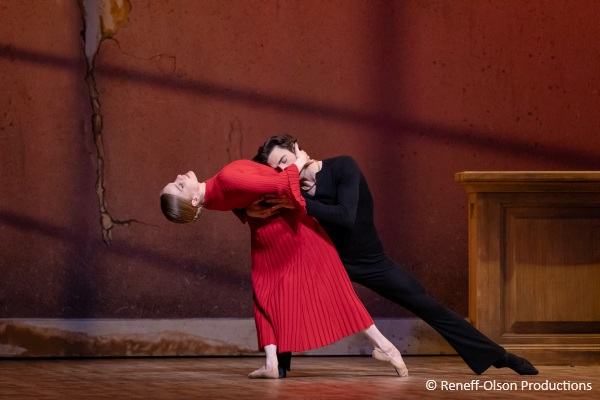
STAND BACK, MALES: TIME FOR ‘DOS MUJERES’
A rousing celebration of Hispanic culture came off with the S.F. Ballet’s “Dos mujeres” program, continuing offstage well into the night before the large and wildly enthusiastic crowd. The entire Opera House was decorated high and low with multi-color South-of-the-Border images, including the oversize flowers enhancing the box seats.
The new Artistic Director Tamara Rojo hit the nail on the cabeza with her unique pairing, one celebrating the Mexican artist Frida Kahlo in the US-premiere gala spectacle “Broken Wings,” the other “Carmen.” “Broken Wings” is a glorious fantasy piece by Annabelle Lopez Ochoa, as if intended for the joyful Mexican Day of the Dead complete with amiable and ambulatory cadavers.
If you were baffled by the gender mishmash, you were not alone. In the latter, dominant tall males with headdresses played female roles, much as in the Harvard Hasty Pudding comedy shows of old. And in Ariella Smith’s “Carmen,” the leading lady (Sasha de Sola on April 4) passionately kisses the bullfighter Escamillo, played by another woman (Jennifer Stahl).
If the Smith “Carmen” had little to do with bullfights, gypsies, tabernas, the opera or Prosper Mérimée’s original novel, it allowed the tempestuous Carmen to ping-pong back and forth between a devoted father figure (Wei Wang) and the despised husband José in black (Joseph Walsh). It was as though the whole far-ranging drama of Carmen were transported to a spartan drawing room, with passions running wild, and Carmen literally sprinting all with them all over.
A few measures of the Bizet opera are quoted in the opening of the helter-skelter Arturo O’Farrill’s score, which overall lacked the high drama required.
But whatever “Carmen” lacked was made up for in the pageantry of “Broken Wings,” which deserves a rerun next season. This drama of the real-life Frida Kahlo wandering through the real world, a fantasy domain and ultimately a beautiful death was powered by the ballerina Isabella DeVivo, plucked from the ranks of mere soloists to take on Frida. On pointe DeVivo appears to become airborne in scene after scene, unawed by the imaginary figures that encroach all about her.
Playing a minor role as Frida’s (renowned) husband Diego was the robust guest artist from Oregon Ballet Theatre John-Paul Simoens—a surprise loaner, given the raft of leading males in the 83-member S.F. Ballet roster who were untapped. No answer is forthcoming, so far.
The wispy story line deals with Frida’s husband, her entering the underworld, then turning into a butterfly and fortified by a spirit headed heavenward. The music by Peter Salem included everything from the song-lament “La Llorona” to a mariachi bringing down the house.
Overall, SFB director Rojo made her point several times over: These works were created by teams of women, for the most part; and, in this region we need some central, focal Latino cultural input, first on stage and extending to lavish Opera House Mexican décor. After the show comes a thunderous all-female mariachi (Mariachi Bonitas de Dinorah) in an unprecedented nightly lobby postlude.
BALLET NOTES—Ochoa’s choreography had been featured here previously in her 2018 “Guernica.” Casts for this run change nightly. This program marked the company’s first-ever double bill of works by Latina choreographers.
‘DOS MUJERES” (Two Women), a program of “Carmen” and the US-premiere “Broken Wings,” through April 14, by San Francisco Ballet. Opera House, S.F. For SFB info: (415) 865-2000, or go online www.sfballet.org.